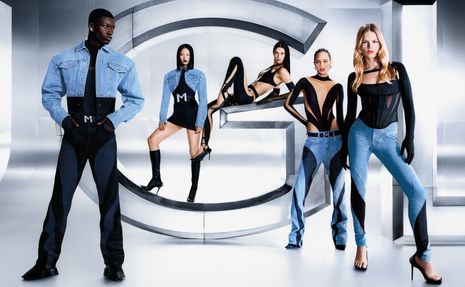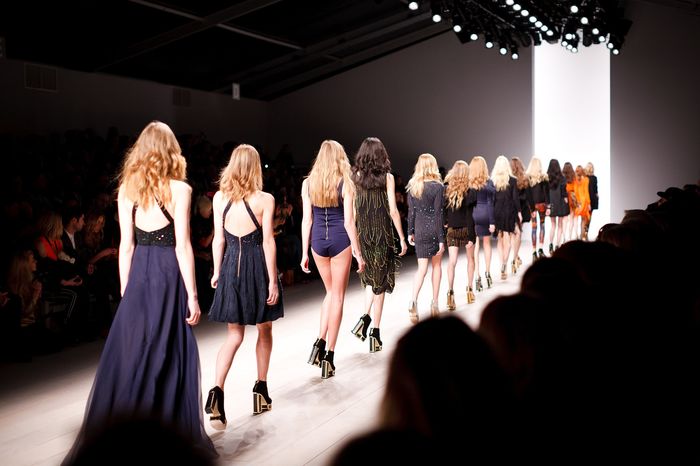H&M x Mugler: High fashion hits an all-time low
Mugler’s fast-fashion collab with H&M is as disappointing as you’d expect, and tells us just how removed the fashion house is from its origins

Any avid browser of high fashion Twitter has no doubt been subject to the quote-unquote “surprising” news of the collaboration between the fast fashion brand H&M and Mugler, one of the world’s most respected high fashion brands. Once famed for its distinctive silhouette of big shoulders, tiny waists and wide hips, the Mugler of the 90s is nearly indistinguishable from the Mugler of today, which now seems to be an endless parade of Fashion Nova-esque bodysuits, all united by their sheer lack of imagination and innovation. In light of this, it is not at all surprising that Mugler has finally decided to break its façade of being ‘high fashion’ by collaborating with H&M. Much of the backlash against this collaboration has been rooted in concern for its impact on Mugler’s image, but it has been painfully obvious for a while now that the Mugler of today is a mere shell of what it used to be.
“Mugler is a brand that now has to rely on gimmicks and marketing to stay relevant”
To illustrate this, I will take the example of two Mugler looks, 30 years apart from each other. First of all, we have the motorcycle bustier from SS92 which melds the female torso with a motorcycle. The model grips her own handlebars, completely subverting the idea that she exists to be driven by anyone else – she is in control of her own destiny on this runway. It is a powerful feminist commentary. Secondly, we have Mugler FW22. The stunning metal details on the motorcycle bustier are reduced to a simplistic, safe V-shape which cups the breasts before giving way to a plain black corset with cut-out details. It doesn’t make a statement. It simply fades away into all the other corset looks that went down the runway, all just as uninspiring as the last. While the motorcycle bustier represents women taking hold of their own destiny and claiming autonomy over their own bodies, the modern-day rendition is an uninspiring pseudo-replica that fails to understand what made the motorcycle bustier so great.
Mugler is a brand that now has to rely on gimmicks and marketing to stay relevant, and this H&M x Mugler collaboration is a product of that. It is not surprising and it is certainly not the cause of a ‘cheapening’ of the brand considering that Mugler had already long cheapened itself before this collaboration was announced. Whether Mugler collaborates with H&M or not, the Mugler of today has departed far enough from its former days of greatness that Thierry Mugler himself is likely rolling in his grave as we speak.
“Something being more accessible doesn’t make it good”
Leading on from that, it is worth asking the bigger question: what are the wider implications of this marriage between fast fashion and high fashion? Ultimately, unethical practices are ripe in the world of fast fashion, and H&M is no exception to this. Collaborations such as this, fed to us consumers under the guise of ‘accessibility’, serve only to widen the profit margins of both brands at the cost of workers’ rights and the health of our planet. Despite promoting itself as a ‘green’ company, H&M has only ranked at a mediocre ‘C’ in sustainability. In order for this H&M x Mugler collection to be profitable at the lower price point, it is likely they will resort to polyester/acrylic blends to drive the production costs down. The argument for high fashion being inaccessible pricewise is that the use of quality materials and the expertise involved naturally demands a higher price. In the conversation about accessibility, it is necessary to ask ourselves what the price of a garment reflects. Is it simply about manufacturing prestige, such as in the case of Chanel and their continually-increasing prices, or is it about charging the true price for the expertise and materials behind a garment?
Whatever the case, it is dishonest to promote this H&M x Mugler collaboration as being a force of good just because it’s more ‘accessible’. Something being more accessible doesn’t make it good, and pointing this out is not inherently elitist. Nor does it come from a desire to preserve the ‘prestige’ of Mugler – as I have repeatedly highlighted, there isn’t much prestige left to preserve in the first place. The biggest problem with this collaboration is that people will not see exploitation when they flock to this H&M x Mugler collection. They will see the designer label as a stamp of approval and purchase accordingly, thus contributing to the ever-growing issue of overconsumption that is plaguing our earth.
Admittedly, I fail to see why anyone would pay actual money to look like a yassified Mermaid Man Spongebob in uninspired mesh cut-out bodysuits and two-tone skinny jeans – but I digress.
 News / Cambridge students set up encampment calling for Israel divestment6 May 2024
News / Cambridge students set up encampment calling for Israel divestment6 May 2024 News / Cambridge postgrad re-elected as City councillor4 May 2024
News / Cambridge postgrad re-elected as City councillor4 May 2024 News / Some supervisors’ effective pay rate £3 below living wage, new report finds5 May 2024
News / Some supervisors’ effective pay rate £3 below living wage, new report finds5 May 2024 Fashion / Class and closeted identities: how do fits fit into our cultures?6 May 2024
Fashion / Class and closeted identities: how do fits fit into our cultures?6 May 2024 News / Academics call for Cambridge to drop investigation into ‘race realist’ fellow2 May 2024
News / Academics call for Cambridge to drop investigation into ‘race realist’ fellow2 May 2024






